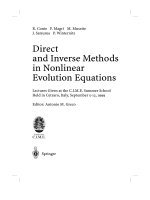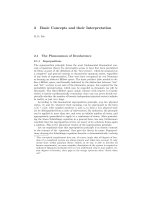Basic Concepts In Nonlinear Dynamics And Chaos
Bạn đang xem bản rút gọn của tài liệu. Xem và tải ngay bản đầy đủ của tài liệu tại đây (248.99 KB, 36 trang )
Basic
Concepts
in
Nonlinear
Dynamics
and Chaos
"Out of confusion comes chaos.
Out of chaos comes confusion and fear.
Then comes lunch."
A Workshop presented at the Society for Chaos Theory
in Psychology and the Life Sciences meeting, July 31,1997
at Marquette University, Miwaukee, Wisconsin. © Keith
Clayton
Table of Contents
•
•
•
•
•
•
•
•
•
Introduction to Dynamic Systems
Nonlinear Dynamic Systems
Bifurcation Diagram
Sensitivity to Initial Conditions
Symptoms of Chaos
Two- and Three-dimensional Dynamic Systems
Fractals and the Fractal Dimension
Nonlinear Statistical Tools
Glossary
Introduction to Dynamic Systems
What is a dynamic system?
A dynamic system is a set of functions (rules, equations) that
specify how variables change over time.
First example ...
Alice's height diminishes by half every minute...
Second example ...
xnew = xold + yold
ynew= xold
The second example illustrates a system with two variables,
x and y. Variable x is changed by taking its old value and
adding the current value of y. And y is changed by becoming
x's old value. Silly system? Perhaps. We're just showing that
a dynamic system is any well-specified set of rules.
Here are some important Distinctions:
•
•
•
•
•
•
variables (dimensions) vs. parameters
discrete vs. continuous variables
stochastic vs. deterministic dynamic systems
How they differ:
Variables change in time, parameters do not.
Discrete variables are restricted to integer values,
continuous variable are not.
Stochastic systems are one-to-many; deterministic
systems are one-to-one
This last distinction will be made clearer as we go
along ...
Terms
The current state of a dynamic system is specified by the
current value of its variables, x, y, z, ...
The process of calculating the new state of a discrete system
is called iteration.
To evaluate how a system behaves, we need the functions,
parameter values and initial conditions or starting state.
To illustrate...Consider a classic learning theory, the alpha
model, which specifies how qn, the probability of making an
error on trial n, changed from one trial to the next
qn+1 = ß qn The new error probability is diminished by ß
(which is less than 1, greater than 0). For example, let the the
probability of an error on trial 1 equal to 1, and ß equal .9.
Now we can calculate the dynamics by iterating the function,
and plot the
results.
q1 = 1
q2 = ßq1 =
(.9)(1) = .9
q3 = (.9)q2 =
(.9)(.9) = .81
etc. ...
Error probabilities for the alpha model, assuming q1=1, ß
=.9. This "learning curve" is referred to as a time series.
So far, we have some new ideas, but much is old ...
What's not new
Dynamic Systems
Certainly the idea that systems change in time is not new.
Nor is the idea that the changes are probabilistic.
What's new
Deterministic nonlinear dynamic systems.
As we will see, these systems give us:
•
•
•
•
A new meaning to the term unpredictable.
A different attitude toward the concept of variability.
Some new tools for exploring time series data and for
modeling such behavior.
And, some argue, a new paradigm.
This last point is not pursued here.
Nonlinear Dynamic Systems
Nonlinear functions
What's a linear function?
Well, gee Mikey, it's one that can be written in the form of a
straight line. Remember the formula ...
y = mx + b
where m is the slope and b is the y-intercept?
What's a nonlinear function?
What makes a dynamic system nonlinear ....
is whether the function specifying the change is nonlinear.
Not whether its behavior is nonlinear.
And y is a nonlinear function of x if x is multiplied by
another (non-constant) variable, or multiplied by itself (i. e.,
raised to some power).
We illustrate nonlinear systems using ...
Logistic Difference Equation
... a model often used to introduce chaos. The Logistic
Difference Equation, or Logistic Map, though simple,
displays the major chaotic concepts.
Growth model
We start, generally, with a model of growth.
xnew = r xold
We prefer to write this in terms of n:
xn+1 = r xn.
This says x changes from one time period, n, to the next,
n+1, according to r. If r is larger than one, x gets larger with
successive iterations If r is less than one, x diminishes. (In
the "Alice" example at the beginning, r is .5).
Let's set r to be larger than one...
We start, year 1 (n=1),
with a population of 16
[x1=16], and since
r=1.5, each year x is
increased by 50%. So
years 2, 3, 4, 5, ... have
magnitudes 24, 36, 54,
...
Our population is
growing exponentially.
By year 25 we have
over a quarter million.
Iterations of Growth model with r = 1.5
So far, notice, we have a linear model that produces
unlimited growth.
Limited Growth model - Logistic Map.
The Logistic Map prevents unlimited growth by inhibiting
growth whenever it achieves a high level. This is achieved
with an additional term, [1 - xn].
The growth measure (x) is also rescaled so that the maximum
value x can achieve is transformed to 1. (So if the maximum
size is 25 million, say, x is expressed as a proportion of that
maximum.)
Our new model is
xn+1 = r xn [1 - xn]
[r between 0 and 4.]
The [1-xn] term serves to inhibit growth because as x
approaches 1, [1-xn]
approaches 0.
Plotting xn+1 vs. xn, we see we have a nonlinear relation.
Limited growth (Verhulst) model. Xn+1 vs. xn, r = 3.
We have to iterate this function to see how it will behave ...
Suppose r=3,
and x1=.1
x2 = rx1[1-x1] =
3(.1)(.9) = .27
x3= r x2[1-x2]=
3(.27)(.73) =
.591
x4= r x3[1-3]=
3(.591)(.409) =
.725
Behavior of the Logistic map for r = 3, x1 = .1, iterated to
give x2, x3, and x4
It turns out that the logistic map is a very different animal,
depending on its control parameter r. To see this, we next
examine the time series produced at different values of r,
starting near 0 and ending at r=4. Along the way we see very
different results, revealing and introducing major features of
a chaotic system.
When r is less than 1
Behavior of the Logistic map for r=.25, .50, and .75. In all
cases x1=.5.
The same fates awaits any starting value. So long as r is less
than 1, x goes toward 0. This illustrates a one-point
attractor.
When r is between 1 and 3
Behavior of the Logistic map for r=1.25, 2.00, and 2.75. In
all cases x1=.5.
Now, regardless, of the starting value, we have non-zero onepoint attractors.
When r is larger than 3
Behavior of the Logistic map for r=3.2.
Moving just beyond r=3, the system settles down to
alternating between two points. We have a two-point
attractor. We have illustrated a bifurcation, or period
doubling,
Behavior of the Logistic map for r= 3.54. Four-point
attractor
Another bifurcation. The concept: an N-point attractor.
Chaotic behavior of the Logistic map at r= 3.99.
So, what is an attractor? Whatever the system "settles down
to".
Here is a very important concept from nonlinear dynamics: A
system eventually "settles down". But what it settles down to,
its attractor, need not have 'stability'; it can be very 'strange'.
Bifurcation Diagram
So, again, what is a bifurcation? A bifucation is a perioddoubling, a change from an N-point attractor to a 2N-point
attractor, which occurs when the control parameter is
changed.
A Bifurcation Diagram is a visual summary of the
succession of period-doubling produced as r increases. The
next figure shows the bifurcation diagram of the logistic
map, r along the x-axis. For each value of r the system is first
allowed to settle down and then the successive values of x
are plotted for a few hundred iterations.
Bifurcation Diagram r between 0 and 4
We see that for r less than one, all the points are plotted at
zero. Zero is the one point attractor for r less than one. For r
between 1 and 3, we still have one-point attractors, but the
'attracted' value of x increases as r increases, at least to r=3.
Bifurcations occur at r=3, r=3.45, 3.54, 3.564, 3.569
(approximately), etc., until just beyond 3.57, where the
system is chaotic.
However, the system is not chaotic for all values of r greater
than 3.57.
Let's zoom in a bit.
Bifurcation Diagram r between 3.4 and 4
Notice that at several values of r, greater than 3.57, a small
number of x=values are visited. These regions produce the
'white space' in the diagram. Look closely at r=3.83 and you
will see a three-point attractor.
In fact, between 3.57 and 4 there is a rich interleaving of
chaos and order. A small change in r can make a stable
system chaotic, and vice versa.
Sensitivity to initial conditions
Another important feature emerges in the chaotic region ...
To see it, we set r=3.99 and begin at x1=.3. The next graph
shows the time series for 48 iterations of the logistic map.
Time series for Logistic map r=3.99, x1=.3, 48 iterations.
Now, suppose we alter the starting point a bit. The next
figure compares the time series for x1=.3 (in black) with that
for x1=.301 (in blue).
Two time series for r=3.99, x1=.3 compared to x1=.301
The two time series stay close together for about 10
iterations. But after that, they are pretty much on their own.
Let's try starting closer together. We next compare starting at
.3 with starting at .3000001...
Two time series for r=3.99, x1=.3 compared to x1=.3000001
This time they stay close for a longer time, but after 24
iterations they diverge. To see just how independent they
become, the next figure provides scatterplots for the two
series before and after 24 iterations.
Scatterplots of series starting at .3 vs. series starting at
.3000001.
The first 24 cycles on the left, next 24 on the right.
The correlation after 24 iterations (right side), is essentially
zero. Unreliability has replaced reliability.
We have illustrated here one of the symptoms of chaos. A
chaotic system is one for which the distance between two
trajectories from nearby points in its state space diverge over
time. The magnitude of the divergence increases
exponentially in a chaotic system.
So what? Well, it means that a chaotic system, even one
determined by a simple rule, is in principle unpredictable.
Say what? It is unpredictable, "in principle" because in order
to predict its behavior into the future we must know its
currrent value precisely. We have here an example where a
slight difference, in the sixth decimal place, resulted in
prediction failure after 24 iterations. And six decimal places
far exceeds the kind of measuring accuracy we typically
achieve with natural biological systems.
Symptoms of Chaos
We are beginning to sharpen our definition of a chaotic
system. First of all, it is a deterministic system. If we observe
behavior that we suspect to be the product of a chaotic
system, it will also be
difficult to distinguish from random behavior
sensitive to initial conditions
Note well: Neither of these symptoms, on their own, are
sufficient to identify chaos.
Note on technical vs. metaphorical
uses of terms:
Students of chaotic systems have begun to use the (originally
mathematical) terms in a "metaphorical" way. For example,
'bifurcation', defined here as a period doubling has come to
be used to refer to any qualititave change. Even the term
'chaos', has become synomous, for some, with 'overwhelming
anxiety'.
Metaphors enrich our understanding, and have helped extend
nonlinear thinking into new areas. On the other hand, it is
important that we are aware of the technical/metaphorical
difference.
Two- and Three-Dimension Systems
First we practice the distinction between variables
(dimensions) and parameters
Consider again the Logistic map
xn+1 = r xn[1- xn]
Multiply the right side out
xn+1= r xn - r xn2,
and replace the two r's with separate parameters, a and b,
xn+1= a xn - b xn2.
Now, separate parameters, a and b, govern growth and
suppression, but we still have only one variable, x.
When we have a system with two or more variables,
•
•
•
its current state is the current values of its variables,
and is
treated as a point in phase (state) space, and
we refer to its trajectory or orbit in time.
Predator-prey system
This is a two-dimensional dynamic system in which two
variables grow, but one grows at the expense of the other.
The number of predators is represented by y, the number of
prey by x.
We plot next the phase space of the system, which is a twodimension plot of the
possible states of the
system.
A = Too many predators.
B = Too few prey.
C = Few predator and
prey; prey can grow.
D= Few predators, ample
prey.
The phase-space of the predator-prey system.
Four states are shown. At Point A there are a large number
of predators and a large number of prey. Drawn from point A
is an arrow, or vector, showing how the system would
change from that point. Many prey would be eaten, to the
benefit of the predator. The arrow from point A, therefore,
points in the direction of a smaller value of x and a larger
value of y.
At Point B there are many predators but few prey. The
vector shows that both decrease; the predators because there
are too few prey, the prey because the number of predators is
still to the prey's disadvantage. At Point C, since there are a
small number of predators the number of prey can increase,
but there are still too few prey to sustain the predator
population. Finally, at point D, having many prey is
advantageous to the predators, but the number of prey is still
too small to inhibit prey growth, so their numbers increase.
The full trajectory (somewhat idealized) is shown next.
The phase-space of the predator-prey system.
An attractor that forms a loop like this is called a limit cycle.
However, in this case the system doeasn't start outside the
loop and move into it as a final attractor. In this system any
starting state is already in the final loop. This is shown in the
next figure, which shows loops from four different starting
states.
Phase-portrait of the predator-prey system, showing the
influence of starting state.
Points 1-4 start with about the same number of prey but with
different numbers of predators.
Let's look at this system over time, that is, as two time
series.
The time series of the predator-prey system.
This figures shows how the two variables oscillate, out of
phase.
Continuous Functions and Differential Equations
•
•
Changes in discrete variables are expressed with
difference equations, such as the logistic map.
Changes in continuous variables are expressed with
differential equations
For example, the Predator-prey system is typically presented
as a set of two differential equations:
dx/dt = (a-by)x
dy/dt = (cx-d)y
Types of two-dimensional interactions
Other types of two-dimensional interactions are possible, as
nicely categorized by van Geert (1991).
•
•
•
mutually supportive - the larger one gets, the faster
the other grows
mutually competitive - each negatively affects the
other
supportive-competitive - as in Predator-prey
The Buckling column system
Abraham, Abraham, & Shaw (1990) used the Buckling
Column system to discuss psychological phenomena that
exhibit oscillations (for example, mood swings, states of
consciousness, attitude changes). The model is a single,
flexible, column that supports a mass within a horizontally
constrained space. If the mass of the object is sufficiently
heavy, the column will "give", or buckle. There are two
dimensions, x representing the sideways displacement of the
column, and y the velocity of its movement.
Shown next are two situations, differing in the magnitude of
the mass.
The buckling column model (Abraham, Abraham, & Shaw,
1990).
The mass on the left is larger than the mass on the right.
What are the dynamics? The column is elastic, so an initial
give is followed by a springy return and bouncing
(oscillations). If there is resistance (friction), the bouncing
will diminish and the mass will come to rest. The equations
are given for completeness only:
dx/dt = y
dy/dt = (1 - m)(ax3 + b + cy)
The parameters m and c represent mass and friction
respectively. If there is friction (c>0), and mass is small, the
column eventually returns to the upright position (x=0, y=0),
illustrated next with two trajectories.
Phase portrait of the buckling column model.
With a heavy mass, the column comes to rest in one of two
positions (two-point attractor), again illustrated with two
trajectories.
Phase portrait of the buckling column model.
Starting at point A, the system comes to rest buckled slightly
to the right, starting at B ends up buckled to the left. Now we
can introduce another major concept...
Basins of attraction
With sufficient mass, the buckling column can end up in one
of two states, buckled to the left or to the right. What
determines which is its fate? For a given set of parameter
values, the fate is determined entirely by where it starts, the
initial values of x and y. In fact, each point in phase space
can be classified according to its attractor. The set of points
associated with a given attractor is called that attractors'
basin of attraction. For the two-point attractor illustrated
here, there are two basins of attraction. These are shown in
the next figure, which has the phase space shaded according
to attractor.
The basins of attraction for the buckling column system.
Reproduced from Abraham et al (1990).
The basin of attraction for the positive attractor (the one on
the right) are shaded. The basin of attraction for the other
attractor is unshaded in the figure. The term seperatrix is
used to refer to the boundary between basins of attraction.
Questions to ponder
Is the buckling column system a chaotic system? Why (not)?
Three-dimensional Dynamic Systems
The Lorenz System
Lorenz's model of atmospheric dynamics is a classic in the
chaos literature. The model nicely illustrates a threedimensional system.
dx/dt = a(y-x)
dy/dt = x(b-z) - y
dz/dt = xy-cz
There are three variables reflecting temperature differences
and air movement, but the details are irrelevant to us. We are
interested in the trajectories of the system in its phase space
for a=10, b=28, c=8/3. Here we plot part of a trajectory
starting from (5,5,5).
The Lorenz system. Only a portion of one trajectory is
shown.
Although the figure suggests that a trajectory may intersect
with earlier passes, in fact it never does. Although not
demonstrated here, the Lorenz system shows sensitivity to
initial conditions. This is chaos, the first strange attractor,
and it has become the icon for chaos.
Beasts in Phase space - Limit Points
There are three kinds of limit points.
•
•
•
Attractors - where the system 'settles down' to.
Repellors - a point the system moves away from.
Saddle points - attractor from some regions, repellor
to others.
Examples
•
•
•
Attractors - we've seen many
Repellors - the value 0 in the Logistic Map
Saddle points - the point (0,0) in the Buckling
Column
Fractals and the Fractal Dimension
Mandelbrot and Nature
"Clouds are not spheres, mountains are not cones,
coastlines are not circles, and bark is not smooth, nor
does lightning travel in a straight line."(Mandelbrot,
1983).
The Concept of Dimension
So far we have used "dimension" in two senses:
•
•
The three dimensions of Euclidean space (D=1,2,3)
The number of variables in a dynamic system
Fractals, which are irregular geometric objects, require a
third meaning:
The Hausdorff Dimension
If we take an object residing in Euclidean dimension D and
reduce its linear size by 1/r in each spatial direction, its
measure (length, area, or volume) would increase to N=rD
times the original. This is pictured in the next figure.
We consider N=rD, take the log of both sides, and get log(N)
= D log(r). If we solve for D. D = log(N)/log(r) The point:
examined this way, D need not be an integer, as it is in
Euclidean geometry. It could be a fraction, as it is in fractal
geometry. This generalized treatment of dimension is named
after the German mathematician, Felix Hausdorff. It has
proved useful for describing natural objects and for
evaluating trajectories of dynamic systems.
The length of a coastline
Mandelbrot began his treatise on fractal geometry by
considering the question: "How long is the coast of Britain?"
The coastline is irregular, so a measure with a straight ruler,
as in the next figure, provides an estimate. The estimated
length, L, equals the length of the ruler, s, multiplied by the
N, the number of such rulers needed to cover the measured
object. In the next figure we measure a part of the coastline
twice, the ruler on the right is half that used on the left.
Measuring the length of a coastline using rulers of varying
lengths.
But the estimate on the right is longer. If the the scale on the
left is one, we have six units, but halving the unit gives us 15
rulers (L=7.5), not 12 (L=6). If we halved the scale again, we
would get a similar result, a longer estimate of L. In general,
as the ruler gets diminishingly small, the length gets
infinitely large. The concept of length, begins to make little
sense.
The "Richardson Effect"
Lewis Fry Richardson first noted the regularity between the
length of national boundaries and scale size. As shown next,
the relation between length estimate and length of scale is
linear on a log-log plot.
The Richardson Effect.
Mandelbrot assigned the term (1-D) to the slope, so the
functions are:
log[L(s)] = (1-D)log(s) + b where D is the Fractal
Dimension.
For Great Britain, 1 - D = -.24, approximately. D = 1-(-.24) =
1.24, a fractional value.The coastline of South Africa is very
smooth, virtually an arc of a circle. The slope estimated
above is very near zero. D = 1-0 = 1. This makes sense
because the coastline is very nearly a regular Euclidean
object, a line, which has dimensionality of one. In general,
the "rougher' the line, the steeper the slope, the larger the
fractal dimension.
Examples of geometric objects with non-integer
dimensions
Koch Curve
We begin with a straight line of length 1, called the initiator.
We then remove the middle third of the line, and replace it
with two lines that each have the same length (1/3) as the
remaining lines on each side. This new form is called the
generator, because it specifies a rule that is used to generate
a new form.
The Initiator and Generator for constructing the Koch
Curve.
The rule says to take each line and replace it with four lines,
each one-third the length of the original.
Level 2 in the construction of the Koch Curve.
Level 3 in the construction of the Koch Curve.
We do this iteratively ... without end.
The Koch Curve.
What is the length of the Koch curve?
The length of the curve increases with each iteration. It has
infinite length. But if we treat the Koch curve as we did the
coastline, ...
The relation between log(L(s)) and log(s) for the Koch curve
...
we find its fractal dimension to be 1.26. The same result
obtained from D = log(N)/log(r) D = log(4)/log(3) = 1.26.
Cantor Dust
Iteratively removing the middle third of an initiating straight
line, as in the Koch curve, ...
Initiator and Generator for constructing Cantor Dust. ...
this time without replacing the gap...
Levels 2, 3, and 4 in the construction of Cantor Dust.
Calculating the dimension ... D = log(N)/log(r) D =
log(2)/log(3) = .63 We have an object with dimensionality
less than one, between a point (dimensionality of zero and a
line (dimensionality 1).
Sierpinski Triangle









